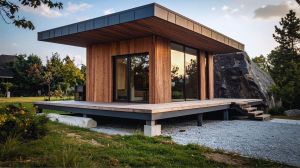Townhouse, Townhome, Row House and Brownstone –
What’s the Difference?
Terms like townhouse, townhome, and row house are easily confused, which can make it difficult to compare properties and find the right one for you. So, what are the differences between them, and which is more suitable for your lifestyle, tastes, and investment goals?
What Is a Townhouse?
A townhouse is a home that shares one or more walls with adjacent properties but has a separate entrance. A townhouse might also have its own outdoor space, such as a front yard, backyard or even both. Townhouses are usually 2 or 3 floors, with clear separation between functional areas.
The ownership structure of a townhouse can be freehold, which means that the property owner owns both the home and the land that it’s on, or it can be a condominium townhouse, meaning that the property owner owns the home but not the land. In condo-style townhouses, ownership of common areas is shared among the property owners in the community. Common areas often include amenities like pools, playgrounds, or fitness centers, which are paid for by Homeowners Association (HOA) fees. HOA fees also cover the exterior maintenance of the units, landscaping, and snow and leaf removal.
What Is a Townhome?
The terms townhouse and townhome are often used interchangeably, and there is no practical difference between them. However, you might find the term townhome used more commonly in newer suburban developments, whereas townhouse is more likely to describe units in traditional neighborhoods.
The use of townhouse versus townhome also varies regionally, so if you’re searching for this type of property, use both search terms. Rest assured, you’ll be looking at the same type of building!
What Is a Row House?
A row house is a specific type of townhouse. It’s essentially an earlier architectural term for the same type of structure, but it often refers to homes with a particular style.
A classic row house is part of a series of homes built in a continuous row with uniform facades. They are usually narrower and more compact than typical suburban townhomes, and more common in older urban areas like those in Philadelphia, Baltimore, or Washington, DC.
You might find the terms row house and townhouse used interchangeably, but when you mention row houses, people typically think of the more traditional architectural details like front stoops, decorative cornices, and brick or stone facades.
Modern row house developments are less common than contemporary townhouse communities, but sometimes developers build new rowhouse-style neighborhoods to recreate the feel of historic urban districts built in the 18th, 19th, and early 20th centuries.
What Is a Brownstone?
A brownstone is a specific type of row house or townhouse named for its exterior building material: brown sandstone. This type of stone was popular in the 19th century, especially in New York, Boston, and parts of Chicago. Brownstones are typically 3 to 5 stories with a front stoop leading to a main entrance. Some iconic neighborhoods with brownstones are Brooklyn’s Park Slope and Manhattan’s Upper West Side. Sometimes buildings clad in different facade materials like red brick or limestone are lumped into the brownstone category.
The ownership structure of brownstones is almost always freehold. Many brownstones have been divided into separate apartments or condominiums, so when someone says that they own a brownstone, they might mean that they own the entire building or that they own a unit inside the building.
Similarities between Townhomes, Townhouses, Row Houses, and Brownstones
Despite their different names and historical contexts, these structures have more in common than what sets them apart. They all have these features:
- Shared walls with at least one adjacent unit.
- Multi-story living arrangements with natural separation between functional areas of the home, such as the living spaces, bedrooms, and entertaining areas.
- Lower heating and cooling costs due to their shared walls.
Most of these homes are freehold, meaning that the homeowner owns both the structure and the land, but there are condominium-style townhouses, townhomes, and row houses. This is usually clearly noted in real estate listings.
Differences That Might Affect Your Choice
Although they have many similarities, there are also differences between these types of structures that could make one style more appealing than the others.
Age and Architectural Style
A modern townhouse in a suburban development will typically feature contemporary design with an open floor plan and updated systems. A historic row house or brownstone will offer more architectural details and character reminiscent of the period in which they were built. They may also require more maintenance and updates to electrical, plumbing, and HVAC systems.
Keep in mind that a home may be built in the style of a row house or brownstone, with reproduced architectural elements and modern systems. If in doubt, check on the year the structure was built and get a thorough home inspection to turn up any issues with the systems.
Location
Newer townhome developments are more likely to be in suburban areas where land is available for larger communities. Row houses and brownstones are almost exclusively in established city neighborhoods, often in historic districts.
Investment Potential
Row houses and brownstones are often in desirable urban neighborhoods. They are also in shorter supply than townhouses, which can lead to more dramatic increases in value. A townhouse in a growing neighborhood is likely to increase in value more steadily, in line with broader property value trends.
Maintenance Costs
A newer townhouse or townhome will be less expensive to maintain than the typical row house or brownstone. This is true even for homes in condominium-style communities, where HOA fees can be quite expensive. Keep in mind that HOA fees cover many of the expenses you would otherwise have to pay yourself.
In terms of maintenance, one advantage of a row house or brownstone is that you have more control over what repairs get done and how much you pay for them. You also make your own decisions about the exterior of the home, and you have fewer restrictions on how you use your outdoor spaces.
Are Townhomes a Good Investment?
Given their potential to appreciate in value and their desirable locations, it may sound as though a rowhouse or a brownstone is a better investment than a townhouse.
However, a townhome will have a lower entry point, making this type of house more accessible to a broader range of buyers. Depending on trends such as employment rates, job growth, and population increases, a townhouse can also appreciate substantially in value over the long term.
One downside of a townhome as an investment is that if there are other properties in the community on the market at the same time, you may have a more difficult time with resale. When selling a brownstone or a row house, you’ll almost certainly have less competition.
Townhouse, Townhome, Row House, Or Brownstone: Which Is Right for You?
Deciding between these popular types of homes depends on your lifestyle, budget, and long-term goals.
If you want predictable costs and low-maintenance living, and you value community amenities, choose a modern townhome. With their location in suburban areas, you’ll also have access to good schools, family-friendly environments like parks and playgrounds, and proximity to shopping malls and a wide range of attractions.
If you appreciate architectural character and period details and you prefer urban living with walkable access to restaurants, shops, and culture, an urban row house or brownstone might be right for you. However, you’ll need to make a significant upfront investment, and you may face unpredictable maintenance costs.
Carefully consider your needs and resources, your investment goals, and your future. With those things in mind, you’ll choose the property that is ideal for you and your family.









